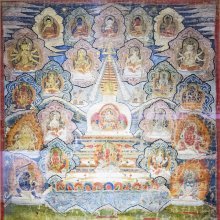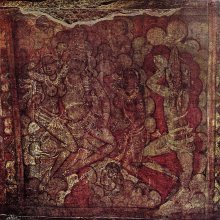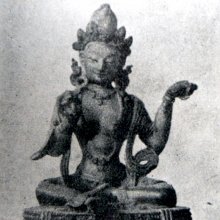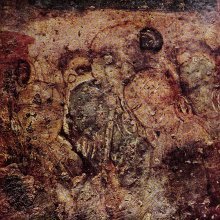Cloud: 4 definitions
Introduction:
Cloud means something in Buddhism, Pali, Hinduism, Sanskrit, the history of ancient India. If you want to know the exact meaning, history, etymology or English translation of this term then check out the descriptions on this page. Add your comment or reference to a book if you want to contribute to this summary article.
Images (photo gallery)
In Hinduism
Natyashastra (theatrics and dramaturgy)
Source: Shodhganga: Elements of Art and Architecture in the Trtiyakhanda of the Visnudharmottarapurana (natya)1) Clouds (as in, the natural phenomenon) are associated with Patāka-hasta: one of the twenty-two Single-hand Gestures (in Indian Dramas) (known as asaṃyuktahastas), according to the Viṣṇudharmottarapurāṇa, an ancient Sanskrit text which (being encyclopedic in nature) deals with a variety of cultural topics such as arts, architecture, music, grammar and astronomy.—The word patāka indicates dhvaja in Sanskrit which means flag or banner. [...] In the Abhinayadarpaṇa, it is said that the patākahasta is used to denote the beginning of a drama. Moreover, this hand posture is used to symbolize some natural phenomenon like cloud, forest, bosom, river, wind etc.
2) Clouds are also associated with Svastikahasta: one of the thirteen Combined-hand Gestures (in Indian Dramas) (known as saṃyuktahastas).—In Sanskrit the word svastika denotes spiritual things. According to the Viṣṇudharmottarapurāṇa, in svastikahasta, both hands are kept in arālahasta. In this posture, the palm should be upward and lying on twisted sides and kept on the wrists. This kind of hastamudrā is used to show something which is widely spread, seasons, sky, cloud, sea and the earth.

Natyashastra (नाट्यशास्त्र, nāṭyaśāstra) refers to both the ancient Indian tradition (shastra) of performing arts, (natya—theatrics, drama, dance, music), as well as the name of a Sanskrit work dealing with these subjects. It also teaches the rules for composing Dramatic plays (nataka), construction and performance of Theater, and Poetic works (kavya).
Shilpashastra (iconography)
Source: Shodhganga: Elements of Art and Architecture in the Trtiyakhanda of the Visnudharmottarapurana (shilpa)Clouds are associated with the Rainy season (Monsoon), which follows specific guidelines of ancient Indian Painting (citra), according to the Viṣṇudharmottarapurāṇa, an ancient Sanskrit text which (being encyclopedic in nature) deals with a variety of cultural topics such as arts, architecture, music, grammar and astronomy.—The Viṣṇudharmottarapurāṇa gives some instructions to make the picture of every season beautiful and natural. As per the Viṣṇudharmottarapurāṇa, Varṣā i.e., the rainy season which is also known as monsoon period should be portrayed with the picture of birds hiding in the trees to get rid of rain, lions and tigers taking shelter in their caves, clouds, rainbow and sparks of lighting in the sky. [...] Thus, the Viṣṇudharmottarapurāṇa addresses various elements of nature, such as clouds in the rainy season, since painting has much connection with time, mood and activity.

Shilpashastra (शिल्पशास्त्र, śilpaśāstra) represents the ancient Indian science (shastra) of creative arts (shilpa) such as sculpture, iconography and painting. Closely related to Vastushastra (architecture), they often share the same literature.
In Buddhism
Tibetan Buddhism (Vajrayana or tantric Buddhism)
Source: ORA: Amanaska (king of all yogas): (Tibetan Buddhism)Clouds (in Sanskrit: Megha) can be controlled by one having the Siddhi (power) of Speech, according to verse 14.24bd-27 of the Laghuśaṃvara, an ancient Buddhist Yoginī Tantra.—Accordingly: “The Sādhaka [who has] the Siddhi of speech can certainly attract a king or queen by [merely] thinking [it]. [...] And he can stop a river, a cart, a machine [like a water-wheel,] the ocean, elephants and horses, clouds (megha), a man or bird merely by means of his speech. He achieves everything which he desires by his speech”.

Tibetan Buddhism includes schools such as Nyingma, Kadampa, Kagyu and Gelug. Their primary canon of literature is divided in two broad categories: The Kangyur, which consists of Buddha’s words, and the Tengyur, which includes commentaries from various sources. Esotericism and tantra techniques (vajrayāna) are collected indepently.
India history and geography
Source: Singhi Jain Series: Ratnaprabha-suri’s Kuvalayamala-katha (history)Clouds (before a storm) (causing shipwreck) during Sea-voyages in ancient India (known in Prakrit as: jattā, or Sanskrit: yātrā) were vividly depicted in the Kathās (narrative poems) such as Uddyotanasūri in his 8th-century Kuvalayamālā (a Prakrit Campū, similar to Kāvya poetry).—Accordingly, [...] A vivid description of the Storm is given consisting of rushing or gathering of clouds, dashing of waves, splashing of sea-monsters, etc. As a result the ship was tossed from side to side, the masts were broken, etc. In such a plight the men on the ship uttered prayers to their respective gods of motley pantheon, [...]. Others vowed to feed Brāhmaṇas on their return. The ship was split into splinters and completely lost into vicious sea, the goods under water, and the sailors all died.

The history of India traces the identification of countries, villages, towns and other regions of India, as well as mythology, zoology, royal dynasties, rulers, tribes, local festivities and traditions and regional languages. Ancient India enjoyed religious freedom and encourages the path of Dharma, a concept common to Buddhism, Hinduism, and Jainism.
See also (Relevant definitions)
Starts with: Cloud god, Cloudberry.
Full-text (+2381): Megha, Jalada, Abhra, Jimuta, Ambuda, Balahaka, Abhriya, Ghana, Varida, Parjanya, Stanayitnu, Payodhara, Payoda, Abda, Jaladhara, Kshapaghana, Kadambini, Varira, Meghaja, Meghamala.
Relevant text
Search found 333 books and stories containing Cloud; (plurals include: Clouds). You can also click to the full overview containing English textual excerpts. Below are direct links for the most relevant articles:
Bhagavati-sutra (Viyaha-pannatti) (by K. C. Lalwani)
Part 3 - Cloud’s power to transform < [Chapter 4]
Part 2 - Kṛṣṇarāji or dark-formation < [Chapter 5]
Part 2 - Beneath the heavens < [Chapter 8]
Yoga Vasistha [English], Volume 1-4 (by Vihari-Lala Mitra)
Chapter XXIV - The aerial journey < [Book III - Utpatti khanda (utpatti khanda)]
Chapter CXVIII - Description of deer, peacocks, cranes &c < [Book VII - Nirvana prakarana part 2 (nirvana prakarana)]
Chapter CXIV - Description of the prospects all around < [Book VII - Nirvana prakarana part 2 (nirvana prakarana)]
The Linga Purana (by J. L. Shastri)
Chapter 54 - Movements of Luminaries (jyotiścakra) < [Section 1 - Uttarabhāga]
Chapter 71 - The statement of Nandikeśvara < [Section 1 - Uttarabhāga]
Chapter 37 - Grant of boons to Brahmā < [Section 1 - Uttarabhāga]
Harivamsha Purana (by Manmatha Nath Dutt)
Chapter 96 - A Description of the Rainy Season < [Book 2 - Vishnu Parva]
Chapter 42 - Jarasandha’s Instructions to the Kings < [Book 2 - Vishnu Parva]
Chapter 15 - An Account of Indra-yajna < [Book 2 - Vishnu Parva]
Tiruvaymoli (Thiruvaimozhi): English translation (by S. Satyamurthi Ayyangar)
Pasuram 4.4.9 < [Section 4 - Fourth Tiruvaymoli (Mannai iruntu tulavi)]
Pasuram 6.10.5 < [Section 10 - Tenth Tiruvaymoli (Ulakam unta Peruvaya)]
Pasuram 4.4.4 < [Section 4 - Fourth Tiruvaymoli (Mannai iruntu tulavi)]
Sahitya-kaumudi by Baladeva Vidyabhushana (by Gaurapada Dāsa)
Related products







